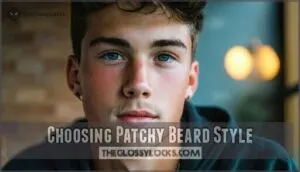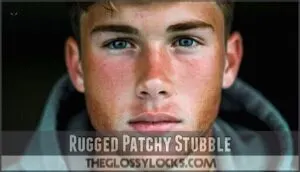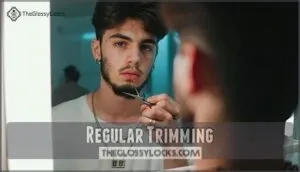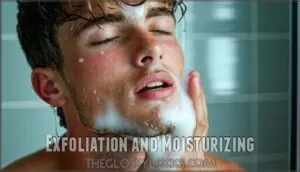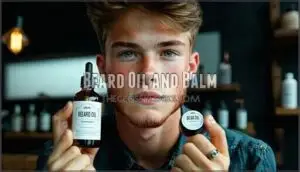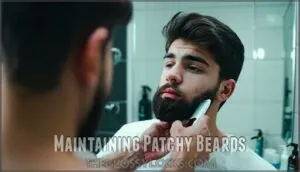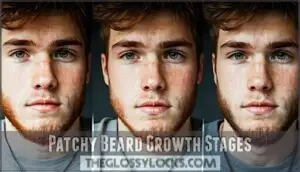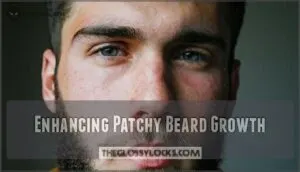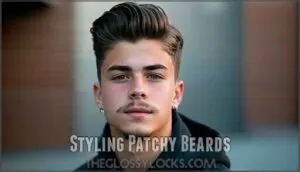This site is supported by our readers. We may earn a commission, at no cost to you, if you purchase through links.

The key is embracing your unique pattern rather than fighting it. Keep your patchy beard styles looking sharp with regular trimming and proper care.
Remember, even celebrities like Johnny Depp and Keanu Reeves started with uneven growth. With the right approach, those sparse patches can become your signature look that sets you apart from the crowd, making you feel more confident.
Table Of Contents
- Key Takeaways
- Patchy Beard Styles
- Causes of Patchy Beards
- Choosing Patchy Beard Style
- Popular Patchy Beard Styles
- Grooming Patchy Beards
- Maintaining Patchy Beards
- Patchy Beard Growth Stages
- Enhancing Patchy Beard Growth
- Styling Patchy Beards
- Caring for Patchy Beards
- Frequently Asked Questions (FAQs)
- How to wear a patchy beard style?
- Can teen boys have a patchy beard?
- What is a bold patchy beard?
- What is a teenage beard style?
- Who has the best patchy beard looks?
- Are mustache and beard styles for teenagers in trend?
- How do I fix my patchy beard at 16?
- Is it rare for a 15 year old to have a beard?
- How should a 17 year old’s beard look?
- Do patchy beards look ok?
- Conclusion
Key Takeaways
- Embrace your patchy beard by choosing styles like light stubble, chin strap, or a goatee that highlight stronger growth and look intentional.
- Take care of your beard with regular trimming, moisturizing, and using beard-friendly oils or balms to enhance growth and manage patchy areas.
- Experiment with different styles to find what works for your face shape, and don’t be afraid to leave sparse patches bare for a clean, stylish look.
- Focus on a healthy routine with protein-rich foods and gentle grooming products to support beard growth and improve overall appearance.
Patchy Beard Styles
You can rock an uneven beard growth and still look cool with the right patchy beard style that fits your face.
Working with what you’ve got means choosing styles that highlight your stronger growth areas while making sparse patches look intentional, not incomplete.
Light Stubble Look
The light stubble look is your best friend when dealing with patchy growth.
Keep it at 1-2mm for a clean, deliberate style that works with uneven coverage. This teen beard style creates shadow without highlighting sparse areas.
Maintaining stubble softness is easy with regular exfoliation and light moisturizer.
It’s versatile enough to complement any hairstyle while minimizing the appearance of adolescent facial hair patchiness.
The overall style is designed to work with the challenges of teen beard growth, making it a practical choice for young men.
Thin Strap Beard
The thin strap beard is one of the go-to teen beard styles for patchy beard solutions. This sleek, low-maintenance style highlights your jawline while keeping it minimal.
- Perfect for adolescent facial hair with uneven growth.
- Works well with various hairstyles for a polished look.
- Adjust strap thickness to suit your face shape.
- Simple grooming makes maintenance easy.
Combining With Goatee
Pairing a goatee with patchy beard styles is a smart move that balances simplicity and edge.
Goatee variations let you highlight areas with thicker growth, giving your look a confident boost.
Choose a style suitable for your face and stick to regular maintenance needs like trimming techniques, it’s perfect for teen beard styles, enhancing facial hair for young men with a smart move.
Causes of Patchy Beards
Patchy beards can happen for several reasons, with hormones and genetics playing a big role. Your DHT levels, which affect beard growth, might also lead to uneven patches.
Hormonal Influence
Patchy beards can sometimes frustrate you, but hormones like testosterone and DHT play a big role in beard growth during your teen years.
Puberty’s timeline shapes how facial hair appears, and androgen receptors determine how well your body responds to these hormones.
Keep patience and remember, uneven growth isn’t permanent.
- Hormonal imbalance may affect growth.
- Testosterone levels influence density.
- DHT production drives thickness.
Genetic Factors
Genetics plays a huge role in teenage beard styles, especially patchy beard styles.
Your inherited traits determine facial hair density and beard growth potential.
If family members have sparse hair, it’s likely you’ll too.
Androgen receptors control how hair follicles respond to hormones, shaping beard density.
Embrace your unique growth pattern—it’s all in your DNA!
DHT Levels
Regarding teenage beard growth, DHT (dihydrotestosterone) plays a big role.
Your DHT levels, combined with receptor sensitivity, determine beard density and growth patterns.
- High DHT levels usually improve growth but don’t guarantee fullness.
- Genetic predisposition influences how your body reacts to DHT.
- Using DHT blockers might hinder growth, so research carefully before trying anything.
Choosing Patchy Beard Style
Picking the right patchy beard style is all about matching it to your face shape, skin type, and personal taste.
Focus on what makes you feel confident, and you’ll turn patchy growth into a signature look.
Face Shape Consideration
Your face shape matters when choosing patchy beard styles.
Round faces benefit from chin straps to create length, while square faces suit defined edges for balance.
Oval shapes work well with most teenage beard styles, emphasizing facial harmony and style symmetry.
The right choice enhances perceived attractiveness by accentuating features, and to achieve this, match your beard’s outline to your natural shape for seamless confidence.
Skin Type Consideration
Choosing a patchy beard style means understanding your skin type. Oily skin can make beards greasy, while dry skin might need extra moisturizing. Sensitive or acne-prone skin benefits from non-comedogenic products.
- Use lightweight beard oils for combination skin.
- Exfoliate gently to avoid irritation.
- Moisturize daily to keep patchy areas soft and prevent flakiness.
Your beard deserves this extra care!
Personal Preference
What’s your vibe? Personal preference shapes patchy beard styles, letting you experiment and express maturity or adopt trends.
From channeling role models to rocking youthful, unique looks, choose what boosts your confidence.
| Preference Type | Beard Style Idea |
|---|---|
| Minimalistic | Light Stubble Look |
| Bold | Goatee with Chinstrap |
| Trendy | Rugged Patchy Stubble |
| Natural | Simple, Natural Growth Beard |
Popular Patchy Beard Styles
You don’t need a full, thick beard to look stylish—patchy beards have their own charm when styled right.
From the sharp Balbo to the rugged stubble, there are plenty of trendy options that suit uneven growth.
Balbo Beard
The Balbo beard is a versatile choice for teens with patchy growth and suits various face shapes.
Celebrities love this style! Here’s how to rock it:
- Keep the cheek area clean-shaven.
- Style a mustache plus a detached chin beard.
- Trim edges for a sharp look.
- Maintain using oils for smooth grooming.
Rugged Patchy Stubble
Got a patchy beard? Rugged patchy stubble is your go-to.
With its uneven yet stylish charm, it celebrates stubble texture and youthful appeal.
This look’s style versatility makes it a hit among teenage beard styles.
Easy maintenance keeps things simple while boosting confidence.
Embrace the imperfections—it turns uneven growth into a bold, confident statement unique to you.
Addressing concerns about hormonal imbalances can sometimes improve growth.
Chin Strap Beard
The chin strap beard takes what works about rugged stubble and gives it more definition.
Perfect for teens with patchy facial hair, this style follows your jawline without covering your cheeks.
For teenage beard style success:
- Trim regularly along your jawline using a precise trimmer
- Keep the line clean and consistent in width
- Don’t worry about patchy spots—they’re part of the charm!
This style particularly flatters round facial structures and has cultural significance across many urban style communities.
Grooming Patchy Beards
You’ll transform your patchy facial hair into a stylish statement with the right grooming routine, even if it’s growing in unevenly right now.
With regular trimming and proper care using beard oils, you can work with what you’ve got to create a look that’s uniquely yours.
Regular Trimming
Now that you’ve explored various patchy beard styles, let’s talk about keeping them looking their best.
Regular trimming is your secret weapon for patchy beard maintenance. You’ll want to use sharp blades and focus on symmetry to make the most of your growth pattern.
A consistent trimming technique every 1-2 weeks helps manage uneven spots and defines your neckline, giving your patchy beard style a clean, intentional look.
Exfoliation and Moisturizing
Beyond trimming, your patchy beard needs proper skin care.
Exfoliate twice weekly to remove dead skin cells that block hair follicles. Simply use a gentle scrub with circular motions.
After exfoliation, moisturizing is your best friend. Apply a non-comedogenic moisturizer to keep skin hydrated.
This teen skincare combo improves patchy beard growth substantially. Remember, healthy skin equals better beard development – it’s basic teenage beard care that really works, focusing on the idea that proper skin care is essential.
Beard Oil and Balm
Transform your patchy beard with the right oil and balm combo.
Beard oils contain skin-nourishing ingredients like argan and jojoba that penetrate deep into follicles, while balms provide styling hold and tame those rebellious hairs.
Apply oil daily after showering, then add balm once oil absorbs, to make your beard more manageable and soft.
This teen beard care routine hydrates, softens, and eliminates issues like itch or beard dandruff.
To find the right product, consider browsing a beard oil selection.
Maintaining Patchy Beards
You’ll need to stay on top of your patchy beard to keep it looking intentional rather than neglected.
Maintaining the right balance means regularly trimming overgrown spots, using teen-friendly beard products, and keeping your facial hair clean with gentle washing, which helps achieve an intentional look by staying on top of your beard’s maintenance.
Avoiding Overgrown Areas
Now that you’ve got your trimming routine down, let’s tackle those wild spots.
You’ll want to keep an eye on areas that grow faster than others.
For patchy beard styles, maintain symmetry by defining borders with strategic trimming.
Focus on neckline shaping and cheekline definition to prevent that "just woke up" look.
Regular trimming helps prevent split ends and stray hairs.
Remember, teenage beard styles look best when the edges are clean, even if the coverage isn’t perfect yet.
Using Beard-Friendly Products
In the realm of patchy beard styles, using the right products makes all the difference.
Choose beard-friendly products with natural ingredients to nurture your uneven growth.
Apply beard oils with gentle circular motions, focusing on dry patches.
Budget options like coconut oil work great for teen beards too!
Patchy beard solutions can help promote growth.
Store products in cool, dry places to maintain effectiveness.
Avoid products containing alcohol to prevent irritation and dryness in your developing facial hair.
Regular Washing and Conditioning
Now that you’ve stocked up on beard-friendly products, let’s talk about keeping your patchy beard clean.
Wash your beard 2-3 times weekly with lukewarm water and a gentle shampoo made for facial hair.
After washing, apply a light conditioner to soften those bristles.
Pat dry carefully—never rub! This simple routine will keep your teen beard looking its best while promoting healthier growth in those patchy spots, following a basic routine.
Patchy Beard Growth Stages
You’ll notice your patchy beard develops in distinct stages, from initial sparse growth to gradually filling in certain areas.
Understanding these growth phases helps you choose styles that work with your current coverage, rather than fighting against nature’s timeline.
First Stage of Growth
The first week of your beard journey marks the initial stage of growth, characterized by light stubble that might look sparse or uneven.
This patchy beard or "baby beard" is completely normal for teen beard beginners, and initial hair appearance often doesn’t match expectations vs reality, but don’t worry!
Early grooming isn’t necessary yet—just stop shaving and let those follicle development processes begin, and remember that patience and persistence are your best friends now.
Second Stage of Growth
While your light stubble is now developing, weeks 2-3 bring the notorious "patchy phase" of beard growth for teens.
You’ll notice uneven growth patterns—denser hair appears on your chin, mustache, and jawline while other areas remain sparse.
Don’t worry! This is normal during beard growth stages, and patience is key—those patches typically fill in as your facial hair growth continues, which is why early patch management includes letting it grow rather than shaving.
Third Stage of Growth
While your light stubble has been developing, you’re now entering the third stage of beard growth from weeks 3-6. This is where the magic happens – your facial hair becomes thicker and more noticeable with darker patches clearly distinguishable.
During this phase, your patchy beard starts filling in, giving you more styling options for either a goatee or full beard. One common cause is hormone imbalances.
- Your confidence will soar as those once-empty patches begin to cover with new growth
- You’ll feel that incredible "I’m actually growing a real beard!" moment when stroking your fuller facial hair
- The satisfaction of seeing your patience rewarded as your beard growth timeline progresses is unmatched
Remember to keep your growing beard clean and moisturized during this pivotal patch coverage period. Many teens find this stage exciting as their beard growth journey really takes shape!
Enhancing Patchy Beard Growth
You can boost your patchy beard’s growth with simple daily habits that work even for teens with uneven facial hair.
From protein-packed meals to gentle brushing techniques, these growth-enhancing methods will help you transform those sparse patches into your best beard yet, with simple habits that can make a significant difference in the appearance of your facial hair, by utilizing growth-enhancing methods.
Eating Protein-Rich Diet
Your body’s beard growth depends heavily on what’s on your plate.
Eating a protein-rich diet fuels your hair follicles and boosts keratin production, directly affecting beard thickness.
| Protein Source | Beard Growth Benefit |
|---|---|
| Eggs | Promotes hair follicle strength |
| Chicken | Supports keratin production |
| Greek yogurt | Enhances beard thickness |
| Lentils | Stimulates natural growth |
| Salmon | Improves overall hair quality |
Try adding these muscle-building foods to your meals to transform that patchy beard into something fuller.
Using Topical Treatments
Applying topical treatments can transform your patchy beard into something magnificent. When conventional methods fall short, these solutions work wonders for uneven growth.
- Try Minoxidil for stubborn patches – it’s like miracle water for your facial hair
- Experiment with derma rolling to wake up those sleeping follicles
- Create a DIY essential oil blend with castor, rosemary, and tea tree oils
Remember, consistency matters most with these beard growth products. Apply according to instructions and give them time to work their magic.
Boar Bristle Brush Benefits
While topical solutions work for some, a boar bristle brush might be your patchy beard’s best friend.
This natural tool works wonders by distributing oils and stimulating growth across your uneven facial hair. You can find a wide selection online.
| Benefit | What It Does | Why It Matters |
|---|---|---|
| Oil Distribution | Spreads natural oils evenly | Softens patchy areas |
| Exfoliation | Removes dead skin cells | Creates healthier growth environment |
| Stimulation | Increases blood flow | Encourages fuller beard development |
| Taming Wildness | Controls direction of growth | Improves overall beard appearance |
Using a boar bristle brush daily can transform your teenage beard’s texture while making the most of what you’ve got, leading to a healthier growth environment and softer patchy areas, which ultimately results in improves overall beard appearance and promotes natural oils distribution.
Styling Patchy Beards
You can turn your patchy beard into a stylish statement by working with your natural growth pattern instead of fighting it.
Embrace your unique facial hair by choosing styles that highlight your stronger areas while minimizing sparse patches, creating a look that’s both intentional and confidence-boosting.
Embracing Patchiness
Now that you understand how nutrition and brushing can help your growth, let’s talk about a mindset shift: embracing patchiness.
Your uneven beard isn’t a flaw—it’s your unique style! Many teens find that acceptance of their natural pattern becomes a confidence boost.
Instead of hiding those sparse areas, consider them part of your self-expression. Some of today’s trendiest teenage beard styles actually showcase those patchy sections as deliberate fashion statements.
Leaving Patchy Areas Bare
Sometimes, the best approach for a patchy beard is to simply leave those sparse areas bare.
Strategic shaving highlights your beard’s strengths while minimizing patchy facial hair. Rather than forcing growth where it’s not happening, work with what you’ve got.
Keep bare skin areas well-moisturized and clean. This patch visibility technique builds style confidence and often looks more intentional than struggling to fill every spot.
Many teenage beard styles actually benefit from this selective approach, particularly if genetic factors influence growth, which can be a key factor in achieving a stylish look.
Experimenting With Styles
The beauty of patchy beards lies in their versatility for experimentation.
Don’t be afraid to try different teen style trends—what looks awkward today might become your signature look tomorrow.
Mix and match elements from popular teenage beard styles like the chin strap or soul patch.
This personal expression builds confidence and lets you find what works with your unique growth pattern, turning patchiness into a deliberate cultural statement.
Caring for Patchy Beards
You’ll need to give your patchy beard the TLC it deserves with proper care routines that support healthy growth and enhance your unique style.
Regular maintenance with the right products won’t just keep your beard looking its best, but will also help you rock that patchy look with confidence that turns "uneven growth" into your signature style.
Trimming Frequency
Nail the perfect trimming frequency for your patchy beard based on your unique growth rate.
Most teens need to trim every 1-2 weeks, but watch how your facial hair develops.
Your maintenance schedule has a huge style impact—too frequent cuts prevent filling in patchy areas, while waiting too long creates an unkempt look.
Keep quality trimming tools handy for quick touch-ups between major beard grooming sessions.
Using Natural Products
Natural ingredients are your patchy beard’s best friend.
They nourish your facial hair while being gentle on teenage skin.
Here are 5 natural products that will transform your beard care routine:
- DIY beard oil using jojoba and argan oils
- Shea butter-based natural balm for moisture retention
- Tea tree and peppermint herbal growth remedies
- Sulfate-free organic shampoo options
- Aloe vera gel for sensitive skin inflammation
Avoiding Harsh Chemicals
While natural products nourish your patchy beard, harsh chemicals can sabotage your growth journey.
Those drugstore products packed with sulfates and alcohols? They’ll strip natural oils and irritate sensitive teen skin.
Instead, check ingredient labels carefully. Many teens with chemical sensitivities find gentle cleansers and DIY beard care recipes work better.
Your patchy beard needs protection from irritation to develop properly. Remember: what you don’t put on your face matters as much as what you do, and using natural products can make a significant difference in your beard’s health, and proper development is key.
Frequently Asked Questions (FAQs)
How to wear a patchy beard style?
Like a patchy garden that still blooms beautifully, your uneven beard can shine too.
Embrace shorter lengths, use beard oil daily, groom regularly, and consider complementary styles like a goatee or chin strap.
Can teen boys have a patchy beard?
Yes, teen boys can absolutely have patchy beards.
It’s completely normal as your facial hair develops.
Embrace what you’ve got – patchiness is just part of the journey as your hormones and genetics work their magic.
What is a bold patchy beard?
A bold patchy beard embraces natural sparseness with confidence.
You’re rocking gaps as part of your style rather than hiding them.
It’s intentionally uneven yet maintained, making a statement about owning your unique facial hair pattern, and this is done with confidence.
What is a teenage beard style?
A teenage beard style is your way to express yourself through facial hair as you grow.
You’ll typically see lighter growth patterns that can be shaped into styles like stubble, chin patches, or minimal mustaches.
Who has the best patchy beard looks?
Zayn Malik and Johnny Depp rock the patchy beard look masterfully.
You’ll also find inspiration from Jason Momoa and Donald Glover, who’ve embraced their natural growth patterns with confidence and style.
Are mustache and beard styles for teenagers in trend?
Around 55% of teens embrace facial hair styles to reflect their personality.
Mustaches and beards are super trendy, with light stubble and simple combos standing out.
They’re easy to maintain and perfect for experimenting.
How do I fix my patchy beard at 16?
Embrace your patchy beard!
At 16, focus on patience, grooming, and good skincare.
Use beard oil for healthier growth and trim regularly.
Patchy areas can rock with a goatee or light stubble style.
Is it rare for a 15 year old to have a beard?
Only about 3% of 15-year-olds grow noticeable facial hair.
It’s not rare, but it’s uncommon.
Hormones and genetics play a big role.
If you’ve got a beard growing, you’re ahead of the curve!
How should a 17 year old’s beard look?
Your beard at 17 should match your growth and vibe.
Go for light stubble, a chin strap, or a subtle mustache.
Stick to styles that enhance your face and are easy to maintain, focusing on a subtle approach to ensure it complements your overall look.
Do patchy beards look ok?
Did you know 45% of teens deal with patchy beards, but they can still look great?
A well-groomed patchy beard adds character and style.
With the right care and confidence, it totally works!
Conclusion
Your patchy beard is like a canvas—you’ve just got to find the right strokes to create a masterpiece.
With the right patchy beard styles for teens, you can highlight your strengths while embracing your unique growth.
Experiment boldly but maintain your look with proper care, like trimming, moisturizing, and using beard-friendly products.
Remember, confidence grows with you, and a patchy beard isn’t a setback—it’s your style statement waiting to shine, so own it and stand out!
- https://www.google.com/search?sca_esv=82dc02b9bfb58d5d&gl=US&hl=en&pws=0&cs=0&sxsrf=AHTn8zr2Oaop6fb3_9dG9YHqtwTtUV860g:1737874130901&q=Beard+styles+for+17+year+old&sa=X&ved=2ahUKEwj9uOTR5ZKLAxXV1QIHHULsEdsQ1QJ6BAgDEAE
- https://teens.webmd.com/boys/puberty-faq-for-guys
- https://www.healthline.com/health/saw-palmetto-hair-loss



